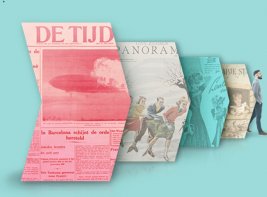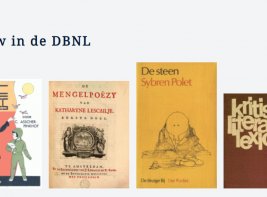Do you want to know what the KB Registration Agency does? And how this service helps to ensure that links to online objects (such as digital publications, images from collections and photographs) always work? Academic institutions assign so-called National Bibliographic Numbers (NBN) to publications. This makes the links to them permanent and ensures that they cannot be lost. The Registration Agency monitors all agreements related to these NBNs and keeps track of which institutions grant them.
What is an NBN?
An NBN is a so-called persistent identifier. This is a unique identification number that always makes it possible to find an object online. It allows you to retrieve the publication, data or object and/or the associated metadata. This prevents dead links.
Want to know more about persistent identifiers? Take a look at the website of Netwerk Digitaal Erfgoed.
For (scientific) institutions with digital collections
Both the KB and a large number of (scientific) institutions, such as universities and colleges of higher education, assign NBNs to their online publications. It is important that these institutions use NBNs. Websites use references to the digital objects of scientific institutions on a large scale. Think of links to publications via social media, literature reviews or platforms such as Het Geheugen or Europeana. If the original internet address changes, the link without NBN would result in a dead link.
What does the Registration Agency achieve?
With the Registration Agency, we help make and keep digital publications accessible. This way, we ensure that (scientific) institutions can use sustainable links.
Digital objects remain accessible
Thanks to NBNs, digital objects can always be found online. The digital collections of (scientific) institutions thus remain accessible to everyone and no knowledge is lost. Even if the URL or the file name changes, the object remains accessible.
Monitoring quality
It is important to monitor the quality of this. This is done with principles and agreements. It is also often checked whether everything in the National Resolver, the national service that refers NBN links to the source location, can also be found at a Long Term Preservation Depot, the depot that preserves digital publications for eternity. And whether everything in the Institutional Repository, the repository for digital publications by an institution, with an URN:NBN:NL is really in the National Resolver. Therefore the Institutional Repository, the Long Term Preservation Depot and National Resolver must deliver lists in the format of URN:NBN:NL's. The Registration Agency must be able to retrieve this information for a specific period.
The principles of the Registration Agency
The Registration Agency adheres to these principles:
- An Institutional Repository [IR] must be located in the Netherlands. The Registration Agency [RA] only has authority over the Dutch subdomain of URN:NBN (URN:NBN:NL). Institutional Repositories [IR] located elsewhere must report to their own national Registration Agency [RA].
- An Institutional Repository [IR] can only grant an URN:NBN:NL to those digital objects that fall within the responsibility of the Institutional Repository [IR] concerned. This is regardless of how the digital object is published, for example by an external institution.
- A digital object can only have one URN:NBN. Other (persistent) identifiers are allowed. A digital object can have (hierarchical) relationships with other digital objects; this must be reflected in the metadata belonging to that digital object.
- Each digital object that is provided with an URN:NBN:NL by an Institutional Repository [IR] must contain the prefix assigned by the Registration Agency [RA] (URN:NBN:NL:). In addition, the URN:NBN:NL must comply with RFC 3188.
- An URN:NBN:NL is only valid if it is registered with the National Resolver [NR].
- If a copy of a digital object is deposited with another Institutional Repository [IR], this copy must be accompanied by the URN:NBN:NL already assigned. The first digital object registered with the National Resolver [NR] is considered to be the original.
- An Institutional Repository [IR] shall deposit each digital object with an URN:NBN:NL at a Long Term Preservation [LTP] Depot recognised by the Registration Agency [RA].
- An Institutional Repository [IR] deposits each assigned URN:NBN:NL together with the URL referring to the location of the digital object in the Institutional Repository [IR] with the National Resolver [NR].
- Once an URN:NBN:NL is assigned, it may not be changed or reused for another digital object. The digital object and the URN:NBN:NL are inextricably linked.
- When changing the content of the digital object, a new URN:NBN:NL must be assigned to the digital object.
Who do we work with?
The Registration Agency monitors all agreements concerning NBN and between stakeholders. It also registers institutions that grant NBNs. The KB does that together with Data Archiving and Networked Services (DANS). They take care of the technical side.
To retrieve a publication or data with an NBN allocated in the Netherlands, there is the National Resolver, managed by DANS.
With NBNs, the emphasis is on the sustainability of publications, data and associated metadata. Therefore, all publications and data to which an NBN has been assigned must be stored in a Long Term Preservation Depot.
The following Long Term Preservation Depositories are recognised by the Registration Agency:
- DANS - EASY Deposit of scientific datasets
- KB - Digital warehouse & durable storage
Agreements concerning the NBNs are held by EduStandaard.
Register digital publications
Do you want to register your digital publication? Mail to @email. Please include the following information in your e-mail:
- Institution | Name, abbreviation, address
- Contact person | First name, last name, e-mail address, telephone number
- Repository | Name, content, OAI-PMH base url
- Deposit copy of contract or working arrangements with a Long Term Preservation Depository recognised by the Registry
- Planning | What, how much and when will an NBN be published?
The application is approved if it meets these requirements for the repository. Which:
- uses OAI-PMH and DIDL/MODS.
- communicates granted NBN to end users including the link to the National Resolver.
- subscribes to the principles that apply to URN:NBN:NL.
- cooperates with quality controls carried out by the Registration Agency.
- submits a planning in which is included what, how much and when the Repository intends to publish with an NBN.


